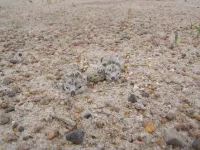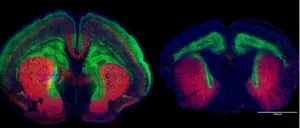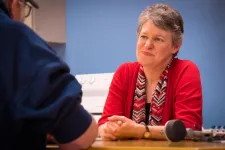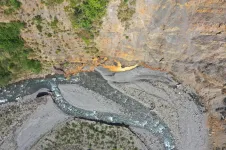Solar and wind power could mitigate conflict in northeast Africa
Research from KU Leuven and VUB on sensitive geopolitical conflict around Ethiopian mega-dam
2021-04-08
(Press-News.org) A new study shows that several disagreements between Ethiopia, Sudan and Egypt around Africa's largest hydropower plant, the new Grand Ethiopian Renaissance Dam (GERD), could be alleviated by massively expanding solar and wind power across the region. Adapting GERD operation to support grid integration of solar and wind power would provide tangible energy and water benefits to all involved countries, creating regional win-win situations. "Our results call for integrated hydro-solar-wind planning to be taken up in the GERD negotiations," says Sebastian Sterl, energy planning expert at Vrije Universiteit Brussel (VUB) and KU Leuven in Belgium and lead author of the study, published in Nature Energy.
For several years, political tensions between Egypt, Sudan and Ethiopia have been escalating in a conflict surrounding Africa's largest hydropower plant: the nearly complete Grand Ethiopian Renaissance Dam (GERD) on the Blue Nile. Ethiopia, which started filling GERD's massive reservoir in 2020, says it needs GERD's electricity to lift millions of its citizens out of poverty. But Egypt is deeply concerned by the mega-dam's consequences for the Nile river, since its agriculture depends completely on Nile water -Egypt raised this issue to the UN Security Council earlier in 2020. Sudan, meanwhile, appears caught between both sides. Ongoing African Union-led mediation talks to agree on long-term operation of the dam have so far yielded little fruit. Certain tongues have even invoked the looming threat of a "water war" between Cairo and Addis Ababa.
Seasonal profiles
Sebastian Sterl, energy planning expert at VUB and KU Leuven and lead author of the study, explains: "The Blue Nile is a highly seasonal river. The GERD's reservoir is so large that it can store the river's full peak flow and deliver hydropower at a stable rate throughout the year, removing the flow seasonality. This makes a lot of sense from the Ethiopian perspective, but it overhauls the natural timing of the water reaching Sudan and Egypt. Behind many disagreements around GERD lies the question of who, if anyone, should be allowed to exert such control over the Nile river."
A group of researchers based in Belgium and Germany, led by Sterl, have now identified a surprising method that could solve multiple disagreements around the dam at once and benefit all three countries. The idea boils down to massively deploying modern, clean solar and wind power to serve as a complement to GERD's hydropower. More concretely: the researchers propose that Ethiopia and its neighbours deploy large-scale solar and wind farms, work towards a regionally integrated power grid, and then agree on Ethiopia operating GERD in synergy with solar and wind power. This would mean turbining less water on sunny and windy days, and more water during cloudy, windless spells and at nighttime, to "firm up" the always-fluctuating solar and wind power.
The researchers realised that sunshine and wind in many regions of Ethiopia, Sudan and their eastern African neighbours have opposite seasonal profiles to the Blue Nile flow. In these places, the sun shines brightest and the winds blow strongest during the dry season. This "seasonal synergy" between water, sun and wind lies at the heart of the researchers' findings.
The study found that, if GERD were operated to back up solar and wind power throughout the year - both hourly and seasonally - this would automatically mean producing less hydropower during the dry season, and more during the wet season, without negatively affecting GERD's yearly average power output. The water flowing out of the dam would then have a seasonality somewhat resembling the natural river flow, with a clear peak in the wet season.
According to Sterl, if GERD were operated in this way, "Essentially, Ethiopia would have all the expected benefits of a big dam - but for Sudan and Egypt, it would look as if the Ethiopians only built a modest, relatively small reservoir. There are many such reservoirs already on the Nile, so no country downstream of Ethiopia could really object to this."
Regional cooperation
By reconciling parties around common energy and water objectives, the researchers identified at least five concrete benefits of such integrated hydro-solar-wind planning. First, Ethiopia could become Africa's largest power exporter while reducing its dependence on hydropower and lowering its electricity generation costs on the long term. Second, consumption of polluting fossil fuels in Sudan and other eastern African countries could be displaced by solar and wind power, backed up by GERD. Third, thanks to the proposed operation scheme of GERD, Egypt could receive more water during dry years than before and would not need to change the operation of its own High Aswan Dam. Fourth, Ethiopia would make more efficient use of its mega-dam's more than a dozen turbines by frequently producing at peak power whenever solar and wind would be unavailable. And fifth, Nile river ecology across Sudan would be less affected by the new dam, as flow seasonality is an important component of rivers' ecological sustainability.
According to the authors, the entire eastern African region stands to contribute. "Ethiopia could theoretically go alone, using GERD to back up its own solar and wind power," says Sterl. "But it would work much better if, say, Sudan were to join in - it has better solar and wind resources than Ethiopia, allowing for better hydro-solar-wind synergies and reducing the overall costs of renewable power generation. Egypt has great solar and wind resources too, as do Djibouti, South Sudan and other eastern African countries. Regional cooperation in a common, Eastern African Power Pool could be key."
The results of the study suggest that integrated hydro-solar-wind planning could be a highly interesting option to discuss in the ongoing GERD negotations between Ethiopia, Sudan and Egypt. "You could call it a win-win situation," says prof. Wim Thiery, climate researcher at VUB and co-author of the study. "The entire region would benefit."
Model
The researchers obtained their results by using a dedicated, highly detailed computer model (REVUB) conceived to simulate the operation of hydropower dams alongside other renewables, like solar and wind power. The model was originally created by the same VUB-researchers in 2019 to study renewable electricity scenarios for West Africa. Later, as the GERD negotiations became more and more present in the media, the researchers realised they could directly apply the same tool to study solar and wind power as potential solutions to the GERD conflict.
INFORMATION:
[Attachments] See images for this press release:

ELSE PRESS RELEASES FROM THIS DATE:
2021-04-08
Piping plovers, charismatic shorebirds that nest and feed on many Atlantic Coast beaches, rely on different kinds of coastal habitats in different regions along the Atlantic Coast, according to a new study by the U.S. Geological Survey and U.S. Fish and Wildlife Service.
The Atlantic Coast and Northern Great Plains populations of the piping plover were listed as federally threatened in 1985. The Atlantic coast population is managed in three regional recovery units, or regions: New England, which includes Massachusetts and Rhode Island; Mid-Atlantic, which includes New ...
2021-04-08
WHAT:
The COVID-19 pandemic is affecting people with or at risk for HIV both indirectly, by interfering with HIV treatment and prevention services, and directly, by threatening individual health. An effective response to these dual pandemics requires unprecedented collaboration to accelerate basic and clinical research, as well as implementation science to expeditiously introduce evidence-based strategies into real-world settings. This message comes from a review article co-authored by Anthony S. Fauci, M.D., director of the National Institute of Allergy and Infectious Diseases (NIAID), part of the National Institutes of Health, and colleagues published in the Journal of Infectious Diseases.
By disrupting critical health care services, the COVID-19 pandemic threatens ...
2021-04-08
April 8, 2021 - Routinely collected data on patients undergoing spinal fusion surgery do not provide a valid basis for assessing and comparing hospital performance on patient safety outcomes, reports a study in Spine. The journal is published in the Lippincott portfolio by Wolters Kluwer.
At a time when hospitals are increasingly subject to online rankings or "pay-for-performance" reimbursement programs, metrics based on hospital administrative data are "unreliable for profiling hospital performance," concludes the new research by Jacob K. Greenberg, MD, MSCI, of Washington University in St Louis and colleagues. ...
2021-04-08
In a medical records study covering thousands of children, a U.S.-Canadian team led by researchers at Johns Hopkins Medicine concludes that while surgery to correct congenital heart disease (CHD) within 10 years after birth may restore young hearts to healthy function, it also may be associated with an increased risk of hypertension -- high blood pressure -- within a few months or years after surgery. ...
2021-04-08
Waste materials from the pulp and paper industry have long been seen as possible fillers for building products like cement, but for years these materials have ended up in the landfill. Now, researchers at UBC Okanagan are developing guidelines to use this waste for road construction in an environmentally friendly manner.
The researchers were particularly interested in wood-based pulp mill fly ash (PFA), which is a non-hazardous commercial waste product. The North American pulp and paper industry generates more than one million tons of ash annually by burning wood in ...
2021-04-08
JUPITER, FL -- Damage to the autism-associated gene Dyrk1a, sets off a cascade of problems in developing mouse brains, resulting in abnormal growth-factor signaling, undergrowth of neurons, smaller-than-average brain size, and, eventually, autism-like behaviors, a new study from Scripps Research, Florida, finds.
The study from neuroscientist Damon Page, PhD, describes a new mechanism underlying the brain undergrowth seen in individuals with Dyrk1a mutations. Page's team used those insights to target the affected pathway with an existing medicine, a growth hormone. It restored normal brain growth in the Dyrk1a mutant mice, Page says.
"As of now, there's simply no targeted treatments available for individuals with autism spectrum ...
2021-04-08
When you think of ways to treat opioid use disorder, you might think methadone clinics and Narcotics Anonymous meetings. You probably don't imagine stretches and strengthening exercises.
But Anne Swisher--professor at the West Virginia University School of Medicine--is working to address opioid misuse in an unconventional way: through physical therapy. She and her colleagues have enhanced physical therapy instruction at WVU to emphasize the profession's role in preventing and treating opioid use disorder.
"Students have different interests and passions within the profession, and they find their niche," said Swisher, a researcher and director of scholarship in the Division of Physical Therapy. "No matter what their passion is, there ...
2021-04-08
EVANSTON, Ill. -- Five-star ratings are no guarantee to lead you to the perfect barber who truly understands your hair or to the espresso machine that brews a perfect cup of coffee.
That's because most products online are now rated positively, making it harder than ever to truly discern whether they will succeed in the marketplace.
A new study from Northwestern University Kellogg School of Management and the University of Massachusetts Boston was able to predict the success of movies, commercials, books and restaurants by relying on the "emotionality" of reviews instead of the star rating.
The researchers explored box office revenue of 2,400 movies, sales of 1.6 million books and real-world reservations at ...
2021-04-08
Astronomers at Western University have discovered the most rapidly rotating brown dwarfs known. They found three brown dwarfs that each complete a full rotation roughly once every hour. That rate is so extreme that if these "failed stars" rotated any faster, they could come close to tearing themselves apart. Identified by NASA's Spitzer Space Telescope, the brown dwarfs were then studied by ground-based telescopes including Gemini North, which confirmed their surprisingly speedy rotation.
Three brown dwarfs have been discovered spinning faster than any other found before. Astronomers at Western University in Canada first measured the rotation speeds of these brown dwarfs using NASA's Spitzer Space Telescope and confirmed them with follow-up ...
2021-04-08
Taiwan is an island of extremes: severe earthquakes and typhoons repeatedly strike the region and change the landscape, sometimes catastrophically. This makes Taiwan a fantastic laboratory for geosciences. Erosion processes, for example, occur up to a thousand times faster in the center of the island than in its far south. This difference in erosion rates influences the chemical weathering of rocks and yields insights into the carbon cycle of our planet on a scale of millions of years. A group of researchers led by Aaron Bufe and Niels Hovius of the German Research Center for Geosciences (GFZ) has now taken advantage of the different erosion rates and investigated how uplift and erosion of rocks determine the balance of carbon emissions ...
LAST 30 PRESS RELEASES:
[Press-News.org] Solar and wind power could mitigate conflict in northeast Africa
Research from KU Leuven and VUB on sensitive geopolitical conflict around Ethiopian mega-dam







